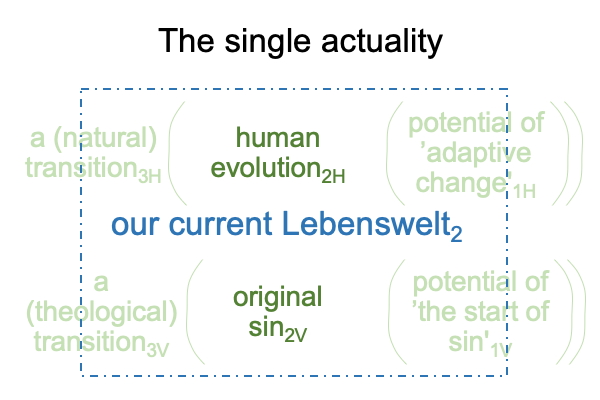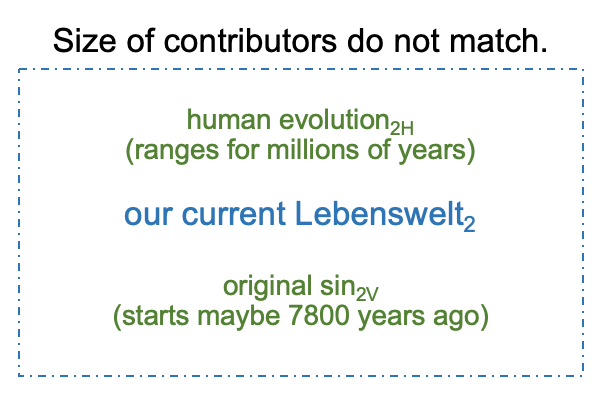0014 In the Introduction, Haarsma states that human evolution2H and the doctrine of original sin2V seem dissonant.
0015 All intersections seem dissonant.
Why?
Two apparently independent actualities constitute a single actuality.
0016 I call the single actuality, “one realness”.
What should I label this “one realness”?
0017 Maybe, the term, “our current Lebenswelt”, will do.
The word, “Lebenswelt”, is German for “living world”.
0018 Here is an initial picture of two actualities constituting a single actuality.

0019 The problem?
Original sin2V applies to our current Lebenswelt, the world after Adam and Eve.
Human evolution2H covers a much longer timeline than our current Lebenswelt.
This introduces a wrinkle to the fabric of Haarsma’s work.
The natural3H and theological transition3V marking the start of our current Lebenswelt2 involves only a fraction of the entirety of human evolution. It is like trying to fix one’s glasses with a tool kit designed for automobiles. It is like cutting a handkerchief from a bedsheet.
0020 Haarsma premises his book on the tenet that there are several possible ways to harmonize human evolution and the doctrine of original sin.
Plus, none of them are good.
Why?
None of them raise the following question, coming from the standpoint of original sin2V and addressing experts on human evolution2H.
Why is our current Lebenswelt is not the same as the Lebenswelt that we evolved in?
0020 Clearly, a natural transition3H and a theological transition3V contextualize the start of our current Lebenswelt2.
Furthermore, our current Lebenswelt2 arises from two, apparently independent, potentials: an adaptive change in human prehistory1H and a cultural change that is captured in the stories of Adam and Eve1V.
As already noted, these two potentials point to the Ubaid, Uruk and Sumerian Dynastic archaeological periods of southern Mesopotamia2.
According to the e-work, The First Singularity And Its Fairy Tale Trace, these two potentials pertain to a cultural change that potentiates civilization (specifically) and unconstrained social complexity (generally)2. This cultural change marks the start of our current Lebenswelt.
0022 In brief, the doctrine of original sin2V challenges the discipline of modern Anthropology2H, which currently proposes a litany of material causes for the potentiation of civilization, such as the birth of agriculture, or the use of irrigation, or population pressures, or this or that material condition.
0023 Original sin2V forces the Christian to ask the scientist, “What if the natural transition3H to our current Lebenswelt is not material?”
This is the location where Loren Haarsma cannot go, because he values the discoveries of natural history and genetics. For years, he has been working with human evolution writ large.
The result is that the initial intersection is lopsided.

On top of that, natural history and genetics cannot propose a scientific hypothesis for a cultural change in the way humans talk.
Semiotics can.
